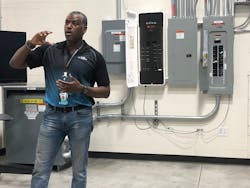T&D World C&E Tech Tour: Duke Energy's Mount Holly Emerging Technology Innovation Center
CHARLOTTE - Mount Holly is situated close by the Catawba River, a relatively small North Carolina city not known for great events but always open to fascinating possibilities in the future.
One of those is a series of otherwise nondescript buildings, highlighted by an array of new-gen grid components and labs. The Mount Holly Emerging Technology Innovation Center, run by Duke Energy, is a place where the future of electricity unfolds, whether it’s microgrids or renewables, energy storage, direct current efficiency studies, electric vehicle charging testing and more.
“We’re always changing things,” Rodney James, technology development manager at Duke and a tour leader for a group of T&D World Conference attendees visiting the Mount Holly microgrid and testing facility, said Wednesday.
Indeed, Mount Holly is where the usual components of microgrid experimentation reside, such as solar panels, battery storage, microturbine and gas generator facilities. But it’s also home to important utility work with unmanned aerial systems, smart meters and switchgear use cases.
And EV chargers, lots of them coming in and out, from the typical station to charging infrastructure built into a streetlight for another unique but potentially important use case.
“We treat energy like water and we’re always filling the bucket,” James noted.
The Duke team at the Mount Holly Emergency Technology Center has worked on countless collaborations with companies both well known and unknown. Some of the former includes S&C Electric, Schweitzer Engineering Laboratories, Tesla and higher education research institutions such as UNC-Charlotte, North Carolina State, Clemson and Georgia Tech.
And those partnerships are ever evolving into new arenas and products, James told the T&D World Conference visitors. Mount Holly will soon be home to testing on the Ford F150 Lightning electric pickup truck, as well as hydrogen-based battery storage technology currently under consideration.
More from the inaugural T&D World Conference and Exhibition in Charlotte
Fleet Electrification and Utilities: The Dance is just Beginning
The Mount Holly also has "Spot," the robotic dog developed by Boston Dynamics. Duke Energy utilizes Spot in several types of research within work spaces in power plants that can prove dangerous to human employees.
And it’s not all sexy renewable, robotics and vehicle electrification work. Among the lab work being done is study in the DC (direct current) bay looking at ways to eliminate so-called “vampire load,” or those devices sucking up electricity even when they appear to be off.
Those juice suckers can make up as much as 10 percent of household consumption, studies show. Somewhere down the road, the innovations on DC load could jump from the micro testing to macro market usage.
“In the long term we’re planning a study on the ‘DC Tiny Home’ concept,” James said.
The Mount Holly Microgrid is a hybrid system refined to a zero black start capability in which you wouldn’t even notice the shift from “islanded” on-site power to full connection to the Duke grid system. Even so, the facility stays islandable probably 75 percent of the workdays, James noted.
All in all, Mount Holly’s Innovation offers Duke an R&D route into the smart grid and decarbonized future, in which energy is treated as preciously as water. And it covers all the energy transition’s key sectors, from e-mobility to distributed energy, energy efficiency, renewables and energy storage of all types.
The inaugural T&D World Conference and Exhibition continues through Friday at the Downtown Sheraton in Charlotte. Participants include utilities such as Duke, Entergy, National Grid, Central Maine and ComEd.
-- -- --
(Rod Walton, senior editor for EnergyTech, is a 14-year veteran of covering the energy industry both as a newspaper and trade journalist. He can be reached at [email protected]).
Follow us on Twitter @EnergyTechNews_ and @rodwaltonelp and on LinkedIn
About the Author
Rod Walton, EnergyTech Managing Editor
Managing Editor
For EnergyTech editorial inquiries, please contact Managing Editor Rod Walton at [email protected].
Rod Walton has spent 17 years covering the energy industry as a newspaper and trade journalist. He formerly was energy writer and business editor at the Tulsa World. Later, he spent six years covering the electricity power sector for Pennwell and Clarion Events. He joined Endeavor and EnergyTech in November 2021.
Walton earned his Bachelors degree in journalism from the University of Oklahoma. His career stops include the Moore American, Bartlesville Examiner-Enterprise, Wagoner Tribune and Tulsa World.
EnergyTech is focused on the mission critical and large-scale energy users and their sustainability and resiliency goals. These include the commercial and industrial sectors, as well as the military, universities, data centers and microgrids. The C&I sectors together account for close to 30 percent of greenhouse gas emissions in the U.S.
He was named Managing Editor for Microgrid Knowledge and EnergyTech starting July 1, 2023
Many large-scale energy users such as Fortune 500 companies, and mission-critical users such as military bases, universities, healthcare facilities, public safety and data centers, shifting their energy priorities to reach net-zero carbon goals within the coming decades. These include plans for renewable energy power purchase agreements, but also on-site resiliency projects such as microgrids, combined heat and power, rooftop solar, energy storage, digitalization and building efficiency upgrades.



